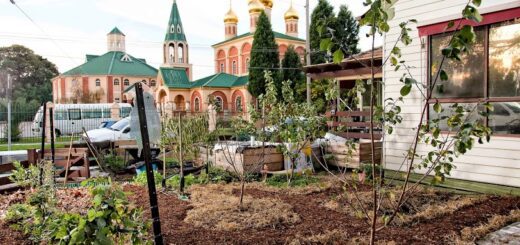Permablitz #169 – Coburg North
We were fortunate to have a warm, mostly sunny day for this blitz at Hamish, Mel and Eddie’s place. Hamish and Mel have been in their house about 15 months and have done some inside renovations to improve layout and increase space and now want to turn their energies to the garden.
The garden design was done by Angelo Eliades of Deep Green Permaculture, who was unfortunately unable to attend the blitz: however a veteran permablitzer, Chamale, was there to provide lots of input and support. As Hamish and Mel’s plans for the backyard and possible house renovations in that space are not finalised yet, the design focused on creating a permanent food forest in the front yard and some moveable beds and wicking beds for the back and side garden.
Prior to the blitz Hamish had prepared the front garden by creating beds around the edges and a large bed in the middle. He had also planted a feijoa hedge against the front fence to provide privacy and protection from the western sun in summer.
The first tasks in the front were to spread a large pile of gravel on the paths and to move a cumquat tree a metre or so. The gravel spreading was done quickly however a dedicated team spent 2 ½ hours digging out the cumquat tree and it was finally re-positioned just before lunch to great cheers.
While the cumquat was receiving attention, steel reinforcing was attached to star pickets in front of the large water tank in the front garden and a passionfruit planted there. The tank should provide a warm micro-climate.
Out the back, cardboard to mulch the front beds was de-stickytaped and others started on transforming some timber used for transporting glass into wicking beds for strawberries and on making a large raised garden bed.
During the day the workers were kept going with plenty of coffee and tea. At morning teatime Mel provided a short talk about sourdough and showed us how to make sourdough crumpets, which were a big hit. Mel had produced enough sourdough starer for participants to take some home. Lunch was a variety of delicious salads.
After lunch, levelling of the large middle front bed and planting of the fruit trees began. As the soil is clay compost and gypsum was added to all the holes. Two avocado trees (A and AB variety to provide cross-pollination), a dwarf nectarine, a dwarf peach and babaco were planted then the areas covered with soaked cardboard and mulch. Small ground covers were planted out around the edges and in the future Hamish will plant more understorey plants. The final touch was the placement of slabs of bluestone for stepping stones.
Out the back work continued on the wicking bed frames and when the first one was finished Hamish gathered us together to demonstrate how to create one. The inside was lined with black plastic and then geotech wicking fabric. A hole was made 1/3 of the way up one end and a pump fitting inserted and screwed down tightly to act as the over flow pipe. Then there was a layer of sand to provide some water retention and protect the plastic from the sharpness of the scoria, which was laid on top of the sand.
The wicking bed was placed in position and levelled so that the water would be evenly distributed then water was poured in to check for leaks. This was a good thing as there was a leak due to holes in the plastic which were fixed by plumbers silicone spread on both sides of the holes. Checking for leaks before the soil is put in makes it much easier to access the leaks for repairs.
Once the bed was watertight the geotech was folded over and covered with potting mix and planted out with strawberries and then mulched.
Meantime two dedicated permablizers had constructed a raised bed two planks high for vegetables.
About 3.30pm we gathered behind the shed for discussion and demonstration about how to make a hot compost pile. The normal proportions of black (manure), green and brown is about 1/3:1/3:1/3 and then the pile is turned after 2 days. As Hamish wanted to wait a week to turn the pile the amount of black was reduced and that of brown increased to slow the process a little. A wire mesh circle was made about 1m by 1m and 1.5m high and all the materials were forked in in layers, which were hosed down regularly.
Not all the jobs for the day were completed however an excellent start was made.
On the list of jobs had been creating a berry trellis, planting raspberries and grapes, planting out a vege box and making a strawberry tower.
Proudly documented by Jan Lansdowne













